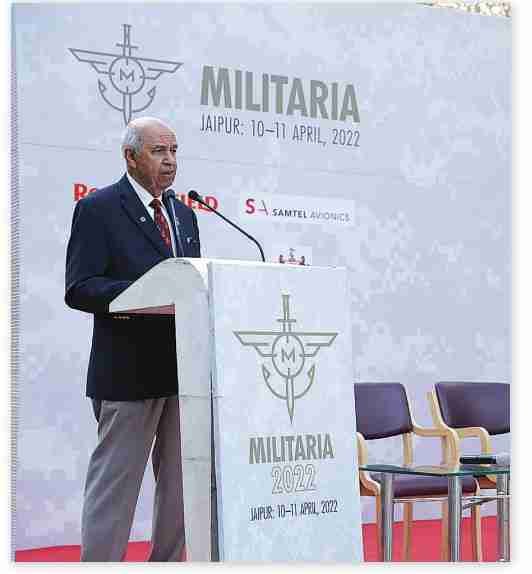On the second day of Militaria-2, Admiral Madhvendra Singh, PVSM, AVSM, ADC, former Chief of Naval Staff (29 December 2001-31 July 2004) gave a brilliant presentation of Indian Navy’s valiant actions during the 1971 India-Pakistan War, at the Narain Niwas Palace Hotel, Jaipur

When then Naval Chief, Admiral S.M. Nanda got the green signal from then Prime Minister Indira Gandhi for the Indian Navy to participate in the 1971 Indo-Pak War, he was raring to go. At a press conference in Jamnagar, November 1971, Admiral Nanda was reported to have said, “….if war comes again, I assure you that we shall carry it right into the enemy’s biggest ports, like Karachi. I know this harbour quite well for I started working there. And you have my word that given the opportunity, the Indian Navy will make the world’s biggest bonfire of it.” That was a promise which he proved true.
In an exclusive interview which he agreed to give at the age of 91 to Rediff.com’s Deputy Managing Editor Ramananda Sengupta he stated: “On the evening of December 4, we towed these boats out half the way, they dropped their tow lines and raced towards Karachi. We hit Karachi, sank two warships and damaged a third. We did this again on December 8 and sank two more ships. One or two missiles hit the oil tanks near the harbour, which set the entire complex ablaze. Karachi burned for seven days.”
Offensive punch
Operation Trident, was the first missile attack on Karachi harbour, on the night of 04/05 Dec 1971, by Indian Naval Ships Kiltan, Katchall, Nipat, Nirghat and Veer. In its maiden missile-boat operation the Indian Navy destroyed and sank PNS Khyber (a Pakistani destroyer), PNS Muhafiz (a coastal minesweeper) and merchant vessel MV-Venus Challenger. This operation was a watershed in ingenuity and strategic thinking as the Indian Navy used bigger ships to tow these smaller missile boats close to the Pakistani ports – something unthinkable even by those who had built these boats. It is fabled that after the attack, Karachi burnt for seven days.
This was a deathly blow to aspirations of the Pakistan Navy and crippled it for years to come. Operation Trident is considered to be one of the most successful operations in modern naval history, with no casualties being sustained by the Indian forces. In another Operation Python, the Indian Navy relentlessly launched another daring attack on the night of 8/9 December, when INS Vinash, along with two frigates, fired four Styx missiles, sinking the Pakistan Naval Fleet Tanker, PNS Dacca and caused substantial damage to Keamari Oil Storage Facility at Karachi. Again, there were no damages reported to the Indian forces. The Squadron was given the title of ‘Killers’ and Indian Navy instituted 04 December as Navy Day.
Over the past five decades the Killers have maintained the capability of delivering a credible offensive punch from the sea. Being the tip of the Sword Arm of the Indian Navy, the battle-ready Missile Vessel Squadron has participated in Op Vijay, Op Parakram and most recently, during the heightened security state following the Pulwama attack deployed within striking distance of Pakistan coast.
The squadron prides itself with distinguished battle honours including one Maha Vir Chakra, seven Vir Chakras and eight Nausena Medals (Gallantry) which are testimony to the gallant spirit of the Killers. These lethal ships capable of high speeds and stealthy strikes, fitted with state-of-the-art weapons and sensors, manned by the youngest and most motivated crew the 22nd Missile Vessel Squadron are the Navy’s assurance to the nation against any misadventure by our adversaries. The President’s Standard being awarded to this fearless formation is a well-deserved tribute to the men who, over the years have rendered invaluable service to the nation as a part of the ‘Killer Squadron’.
Indian Navy’s brave fight
Some Indian Navy personnel and their valiant actions which led to the Indian Navy’s grand victory and also contributed to Indian Armed Forces defeating Pakistan in merely thirteen days, deserve mention.
On the night of 04/ 05 December 1971, a Task Group of the Western Fleet commanded by Commander Kasargod Patnashetti Gopal Rao carried out an offensive sweep on the port of Karachi. Notwithstanding the threat of enemy air, surface and submarine attacks, his Task Group penetrated deep into enemy waters and located two groups of large enemy warships and despite heavy gun fire from enemy destroyers, carried out a determined attack which resulted in the sinking of two enemy destroyers and one minesweeper.
After the surface engagement with enemy warships, Commander Rao led his Task Group to invade deep into enemy waters and successfully bombarded Karachi port setting fire to oil and other installations in the harbour. For his conspicuous gallantry and outstanding leadership in this operation, Commander Gopal Rao was awarded the Maha Vir Chakra (MVC).

Commander Babru Bhan Yadav, who, on the night of 04/ 05 December 1971, was the squadron commander of a division of ships ordered to carry out an attack on the port of Karachi, did so with exemplary courage and audacity. Deploying his division of ships deep into the enemy waters and encountering two groups of large enemy warships, despite facing heavy gun fire from the enemy destroyers, Commander Yadav led his squadron in a swift and determined attack, resulting in two enemy destroyers and one minesweeper being sunk. For his conspicuous gallantry and leadership of a high order he was awarded the MVC.
Captain Mahendra Nath Mulla, a senior officer of the Frigate Squadron assigned the task of locating and destroying a Pakistan submarine in the North Arabian Sea, was the Captain of INS Khukri. On the night of 09 December 1971, INS Khukri was hit by torpedoes fired by an enemy submarine and consequently sank. Having decided to order all ranks to abandon ship, Captain Mulla without regard to his own personal safety supervised the arrangement for rescue of his ship’s personnel in a very cool, calm and methodical manner.
Even at a later stage, whilst the ship was sinking, he showed presence of mind and continued to direct the rescue operation and refused to save himself by giving his own life saving gear to a sailor. Having directed as many of his men as possible to leave the ship, Captain Mulla went back to the bridge to see what further rescue could be done. He was last seen going down with his ship. With his action and demeanour he set an example in keeping with the highest traditions of the Service and was awarded the MVC.
Never give up!
Lieutenant Commander Joseph Pius Alfred Noronha was the Commanding Officer of INS Panvel, which formed part of the force entrusted with the task of attacking enemy targets in Mongla and Khulna areas in erstwhile East Pakistan from 08-11 December 1971.
Operating off Khulna and facing incessant air attacks as well as fire ftrom enemy shore defences, Lt Cdr Noronha competently and fearlessly handled INSPanvel in very restricted waters while effectively engaging the enemy positions on the waterfront. His bravery, utter disregard to his personal safety, leadership and untiring energy inspired his men to rise to the occasion and fight the enemy in close quarter combat for a prolonged period. Lt Cdr Noronha succeeded in silencing enemy shore defences and causing extensive damage to vital enemy installations. For his conspicuous gallantry and leadership, he was awarded the MVC.
Cdr MN Samant, was a senior officer of Force A, which carried out daring and highly successful attacks on enemy ports of Mongla, Chalna and Khulna on 09/10 December 1971. Manoeuvring his squadron through a hazardous and unfamiliar route, Cdr Samant achieved complete surprise and routed the enemy in Mongla, inflicting heavy losses. He then proceeded to attack Khulna to destroy the enemy entrenched in strength. Cdr Samant inspired his men to rise to the occasion and fight most gallantly and was awarded the MVC
Lieutenant Commander (later Rear Admiral) Santosh Kumar Gupta, Commanding Officer of the Navy air squadron, operating from the aircraft carrier INS ‘Vikrant’, led eleven very successful strike missions with devastating effects on enemy ships and heavily defended shore facilities in various sectors of erstwhile East Pakistan.
As enemy shore defences opened fire at the survivors in the water, Leading Seaman Singh noticed that two survivors, including an injured officer, who were finding it difficult to keep afloat. In spite of his injuries and unmindful of his personal safety he went to their rescue and escorted them to the shore through heavy enemy fire.
On 9 December 1971, Lieutenant Commander Gupta pressed home a strike of Seahawk aircraft against enemy targets in Khulna while facing a fierce barrage of anti- aircraft gunfire. Despite his aircraft being hit and damaged by enemy fire, regardless of his personal safety and in the face of extreme danger, he continued to lead the attack with indomitable determination and skill and then led his divisions on board back to safety. For great courage and professional ability in landing his damaged aircraft safely on board the carrier, he was awarded the MVC.
Leading Seaman (later Petty Officer) Chiman Singh was member of a ship which attacked enemy targets in the Mongla and Khulna area from 8 to 11 December 1971. While operating off Khulna his boat was sunk and he was very badly wounded by shrapnel. As enemy shore defences opened fire at the survivors in the water, Leading Seaman Singh noticed that two survivors, including an injured officer, who were finding it difficult to keep afloat. In spite of his injuries and unmindful of his personal safety he went to their rescue and escorted them to the shore through heavy enemy fire.
On reaching the shore, yet again despite his wound he rushed at the enemy, thereby making it possible for his two colleagues to escape from being captured by the enemy. Leading Seaman Singh was eventually overpowered and taken prisoner by the enemy. On the liberation of Bangladesh, he was recovered and admitted to hospital and eventually, for great gallantry and grit, he was awarded the MVC.
Chiman Singh’s action was part of Operation X, the covert naval war in erswhile East Pakistan in 1971, which was put together in a book with the same title by Captain M.N.R. Samant, one of IN’s hardcore professionals and Sandeep Unnithan, the journalist son of a naval officer and it turned out to read like an unputdownable thriller.
Launched in October 2019, by former Naval Chief Admiral V.S. Shekhawat, the book describes how Commander Vijai Prakash Kapil, Vir Chakra and Petty Officer Chiman Singh trained 176 East Pakistani Bengali youth as combat swimmers launching simultaneous attacks on the ports of Chittagong, Chalna-Mongla, Narayanganj and Chandpur on the night of August 15, 1971. They sank 44,500 tons of shipping and damaged 14,000 tons, the largest amount in a single attack by naval saboteurs since the Second World War.
There are many more instances of valour, some not so well known and many of unsung bravehearts in this unique war.

